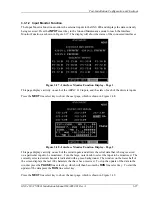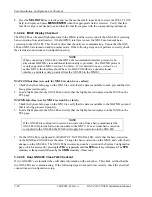
Post-Installation Configuration & Checkout
GNS 480 (CNX80) Installation Manual560-0982-01 Rev A
3-39
3.3.2.4.9 Autopilot
The GNS 480 provides GPSS roll steering information to an appropriate autopilot. When connected
properly, the autopilot will show a GPSS valid indication when the GNS 480 has a valid GPS position
and is navigating to a waypoint.
NOTE
Some autopilots require that groundspeed be above a certain threshold in order for GPSS
to be valid. This is accomplished by placing the GNS 480 in Simulator Mode.
This check verifies that the autopilot is receiving data from GNS 480. Ensure that the autopilot is turned
on and in normal mode. If the following steps do not perform correctly, check the electrical connections
and configuration setup.
1.
Apply power to the equipment, and after the GNS 480 splash screen clears press the
SUSP
bezel key
on the GNS 480
three times
to go into Simulator Mode. Press the
MENU/ENTER
key to
acknowledge entry into the Simulator Mode. Allow the GNS 480 to complete its normal start-up
sequence.
2.
In the GNS 480, set a course to a destination waypoint. This can be done by pressing the
NRST
bezel
key to display a list of nearby waypoints. Then use the large, outer knob to select a suitable waypoint
and press the
DIRECT-TO
bezel key, followed by the
Direct
line select key.
3.
Press the
MAP
bezel key and then press the
SPD
smart key to verify the simulated ground speed.
Ensure that the ground speed is set to 120 kts (if necessary, the ground speed can be adjusted using
the small, inner knob and then pressing the
MENU/ENTER
key to acknowledge the entry).
CAUTION
When the autopilot is engaged, flight control surface movement can occur.
4.
Engage the autopilot in GPSS mode.
Verify that GPSS is valid via the autopilot annunciation.
5.
Press the CDI Select key to select Nav data on the CDI. Verify that the autopilot annunciates GPSS
Fail.
6.
Exit the Simulator Mode by turning the GNS 480 off and then back on.
7.
Verify all other connections between the GNS 480 and the autopilot (e.g. the deviation signals and
flags). These signals can be simulated using the Ground Maintenance mode (see section 3.3.1).
3.3.2.4.10 RMI/OBI
The GNS 480 RMI/OBI output can be used to drive an RMI (or OBI) navigation indicator. This check
verifies that the RMI/OBI is receiving data from the GNS 480. If the following steps do not perform
correctly, check the electrical connections and configuration setup.
1.
Apply power to the equipment and wait for the GNS 480 to acquire a position.
2.
In the GNS 480, set a course to a destination waypoint. This can be done by pressing the
NRST
bezel key to display a list of nearby waypoints. Then use the large, outer knob to select a suitable
waypoint and press the
DIRECT-TO
bezel key, followed by the
Direct
line select key.
3.
If an external RMI select switch is installed, set it to the GPS position (if no switch is installed, the
GNS 480 output automatically defaults to GPS data).
4.
Verify that the RMI needle swings and points towards the GPS waypoint selected
NOTE
The aircraft heading system must be operating properly in order for the RMI needle to
point correctly.
Summary of Contents for GNS 480
Page 1: ...GNS 480 CNX80 Color GPS Nav Com Installation Manual September 2004 560 0982 01 Rev A...
Page 10: ...Table of Contents viii 560 0982 01 Rev A GNS 480 CNX80 Installation Manual NOTES...
Page 30: ...General Information 1 20 560 0982 01 Rev A GNS 480 CNX80 Installation Manual NOTES...
Page 126: ...Periodic Maintenance 6 2 560 0982 01 Rev A GNS 480 CNX80 Installation Manual NOTES...
Page 150: ...Appendix D Interconnect Diagrams D 2 560 0982 01 Rev A GNS 480 CNX80 Installation Manual NOTES...
Page 185: ......
Page 186: ......






























